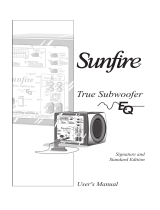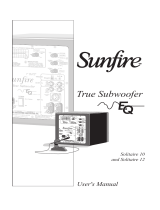Page is loading ...

Basic Guidelines
A graphic equalizer adjusts the sound of your audio system. Before setting the sliders, listen to your system and ask
yourself what you'd like to change about its sound. If you want more bass, for example, either raise the low frequency
sliders or lower the midrange or high frequency sliders. Conversely, if you'd like to hear more high frequencies, either
raise the high frequency sliders or lower the midrange or bass frequencies.
Using The Controls
Power
Press this switch to turn the unit on or off. The red LED in the switch will light to show power is on.
Level
This knob controls the volume level of the EQ’s output.
Line
This switch refers to the hookups on the back of the EQ 10.1. If you are using XLR or balanced inputs (line 2),
depress this button. If you are using RCA or unbalanced inputs (line 1), leave this button in the out position.
EQ/Pass
Use this switch to compare the equalized and unequalized sound. Depress this button to hear the equalized sound.
Leave this switch in the out position to hear the unequalized sound.
EQ Sliders
There are ten sliders, each of which has a range of 12 dB to boost or cut its particular frequencies. The lowest
frequency slider is 30 Hz, and the highest is 16 kHz. The range of this EQ corresponds with all but the extremes
of human hearing. Adjusting the sliders makes it simple to alter the sound of your system. For instance, the lowest note of a bass guitar is around 42 Hz.
Adjusting the 30 hz and 60 Hz sliders adjusts the level of the bass guitar, bass drum, and other instruments within this frequency range.
Hooking It Up
When connecting the EQ 10.1,
turn off or unplug your
components. This prevents
loud “pops” that might
damage your speakers
while you connect the cables.
We recommend that you use
the EQ 10.1 with a pream-
plifier or other sort of mixer.
The diagram at right shows
the EQ 10.1 in conjunction
with other components
from AudioSource’s modular
separates line. You can
substitute any amp or
preamp; the setup is the
same. Also, XLR/balanced connections follow the same paths as the RCA/unbalanced connections described below. Since most audio systems are con-
figured in stereo, this diagram includes two EQ 10.1s. You may use either of the two for the left or right channel. If you have a single EQ 10.1 in a
mono setup, simply adapt the diagram above by omitting one of the stereo connections.
1. Connect the source component (e.g. DVD player, CD player, cassette deck, microphone) to the preamp input.
2. Connect the two output channels of the preamp to each of the EQ inputs. In this diagram, Channel 1 is left and Channel 2 is right.
3. Connect the outputs from each EQ to the amplifier inputs. Please note that the Amp 5.1 is also a single-channel amplifier, which is why two of them are
required in this example. Rather than two monoblocks, you could also use a single stereo amplifier, such as an Amp 6.2 or 6.3.
5
4
3
2
1
Owner’s Manual
Line 2 In
Line 2 Out
120 VAC 60 Hz 12 Watts
Line 1 OutIn
EQ 10.1
Balanced Input
Speaker Output
+
–
Unbalanced
Line In
Line Out/
Thru
120 VAC 60 Hz 200 Watts
Amp 5.1
Balanced Input
Speaker Output
+
–
Unbalanced
Line In
Line Out/
Thru
120 VAC 60 Hz 200 Watts
Amp 5.1
Line 2 In
Line 2 Out
120 VAC 60 Hz 12 Watts
Line 1In Out
EQ 10.1
Ch. 1 In Ch. 2 In
Ch. 1 Out
Line 2
Line 2
Ch. 2 Out
120 VAC 60 Hz 12 Watts
Ch. 1 Ch. 2 OutCh. 1 Ch. 2
Line 1
Preamp 5.1
Audio Out
L
Audio In
R
DVD Player,
CD Player or
Other Source
Modular Ten-Band Graphic Equalizer
EQ 10.1
Note: If any part of this product is damaged or missing, do not contact your AudioSource dealer. Please call us directly at 800-435-7115.

This manual provides detailed instructions for setting up your equipment. We also offer friendly, toll-free assistance.
1.800.HELP.115
9300 North Decatur
Portland, OR 97203
Tel. 503.286.9300
Fax 503.978.3302
audiosour[email protected]
www.audiosource.net © 2000 AudioSource, Inc.
Read Instructions
All the safety and operating instructions should be read before the appliance
is operated.
Retain Instructions
The safety and operating instructions should be adhered to.
Heed Warnings
All warnings on the appliance and in the operating instructions should be
adhered to.
Follow Instructions
All operating and use instructions should be followed.
Water and Moisture
The appliance should not be used near water. For example, near a bathtub,
washbowl, kitchen sink, laundry tub, in a wet basement, or near a swimming
pool, etc.
Ventilation
The appliance should be situated so that its location or position does not
interfere with its proper ventilation. For example, the appliance should not be
situated on a bed, sofa, rug, or similar surface that may block the ventilation
openings; or, placed in a built-in situation, such as a bookcase or cabinet that
may impede the flow of air through the ventilation openings.
Heat
The appliance should be situated away from heat sources such as radiators, heat
registers, stoves, or other appliances (including amplifiers) that produce heat.
Power Sources
The appliance should be connected to a power supply only of the type
described in the operating instructions or as marked on the appliance.
Grounding or Polarization
Precautions should be taken so that the grounding or polarization means of
an appliance is not defeated.
Power Cord Protection
Power supply cords should be routed so that they are not likely to be walked
on or pinched by items placed on or against them, paying particular attention
to cords at plugs, convenience receptacles, and the point where they exit from
the appliance.
Cleaning
The unit should be cleaned only as recommended by the manufacturer.
Power Lines
An outdoor antenna should be located away from power lines.
Non-Use Periods
The power cord of the appliance should be unplugged from the outlet when
left unused for a long period of time.
Object and Liquid Entry
Care should be taken so that objects do not fall and liquids are not spilled
into the enclosure through openings.
Damage Requiring Service
The appliance should be serviced by qualified service personnel when: a) The
power supply cord or the plug has been damaged; b) Objects have fallen, or
liquid has been spilled into the appliance; c) The appliance has been exposed
to rain; d) The appliance does not appear to operate normally or exhibits a
marked change in performance; or e) The appliance has been dropped, or the
enclosure damaged.
Servicing
The user should not attempt to service the appliance beyond that described in
the operating instructions. All other servicing should be referred to qualified
service personnel.
Product Servicing
In the event your EQ 10.1 fails to operated properly, please contact the dealer
where you purchased the unit. Or you may contact AudioSource directly for
further assistance.
Safety Instructions
Warning: To reduce the risk of fire or electric shock, do not expose this appliance to rain or moisture.
Caution: To reduce the risk of electric shock, do not remove cover (or back); no user serviceable parts inside. Refer servicing to qualified service personnel.
Caution: To prevent electric shock, match wide blade of plug to wide slot, fully insert.
Attention: Pour eviter les chocs electriques, introduire la lame la plus large de la fiche dans la borne correspondante de la prise et pousser jusqu'au fond.
The lightning flash with arrowhead symbol, within an equilateral triangle, is intended to alert the user to the presence of uninsulated dangerous voltage within the prod-
uct's enclosure that may be of sufficient magnitude to constitute a risk of electrical shock to persons. The exclamation point within an equilateral triangle is intended to
alert the user to the presence of important operating and maintenance (servicing) instructions in the literature accompanying the appliance.
CAUTION
RISK OF ELECTRIC SHOCK.
DO NOT OPEN.
Frequency Response . . . . . . . . . . . . .10 Hz to 100 kHz ±1 dB
Signal to Noise Ratio . . . . . . . . . . . . . . . . . . . . . . . . . .>95 dB
Input Impedance . . . . . . . . . . . . . . . . . . . . . . . . . .47k Ohms
Output Impedance . . . . . . . . . . . . . . . . . . . . . . . . .600 Ohms
Inputs . . . . . . .Line 1 (RCA/Unbalanced), Line 2 (XLR/Balanced)
Outputs . . . . .Line 1 (RCA/Unbalanced), Line 2 (XLR/Balanced)
Control Range . . . . . . . . . . . . . . . . . . . . . . . . . . . . . . .±12 dB
Power Consumption . . . . . . . . . . . . . . . . . . . . . . . . . .6 Watts
Dimensions . . . . . . . . . . . . . 7.125" x 2.25" x 16.5", 3.25 lbs.
EQ 10.1 Specifications
Design and specifications are subject to change without notice.
/




